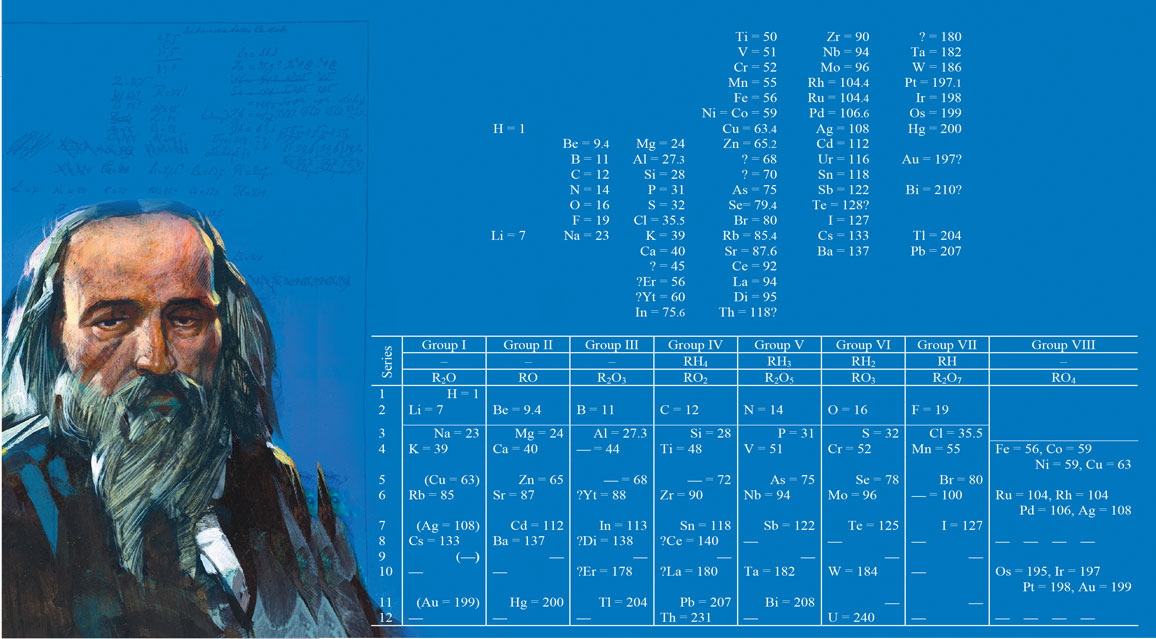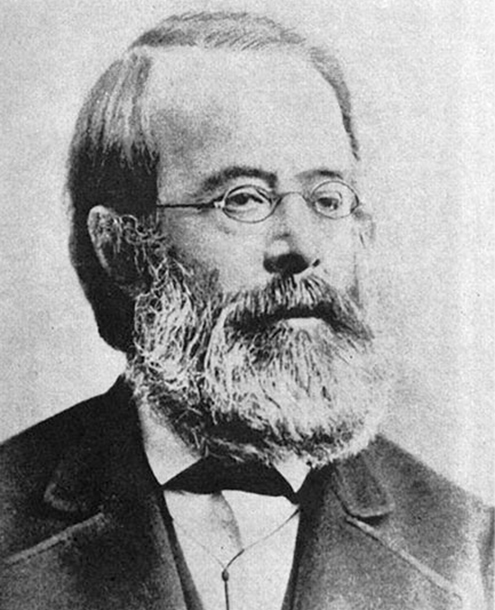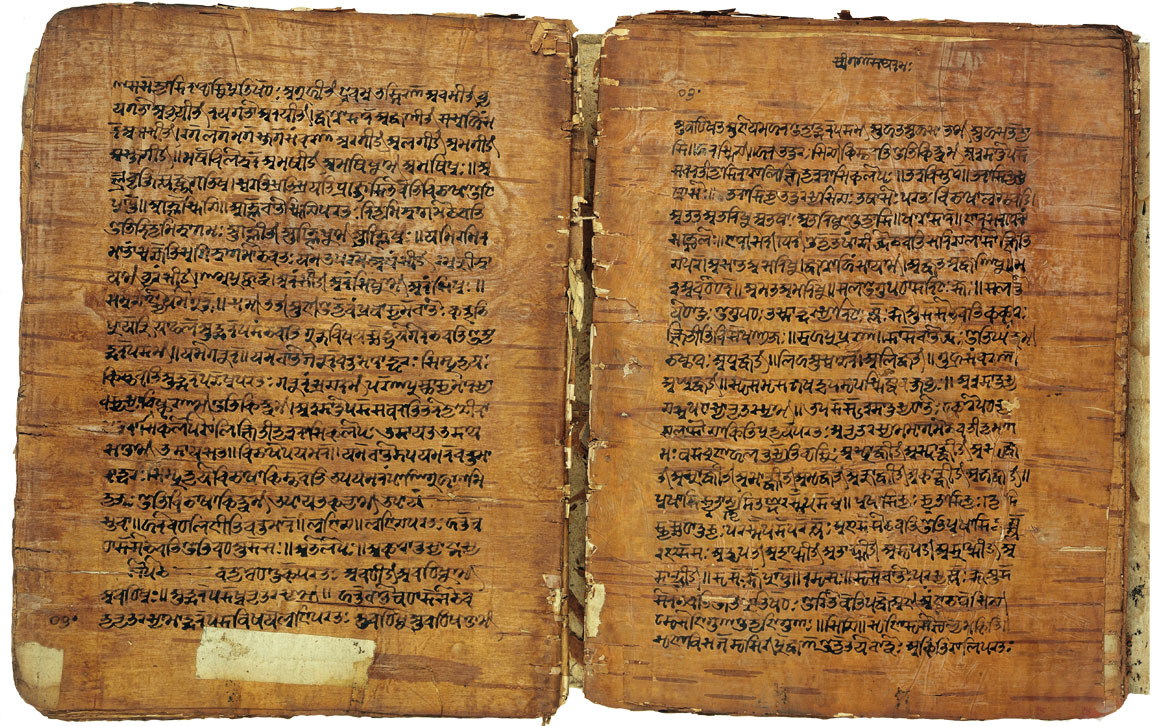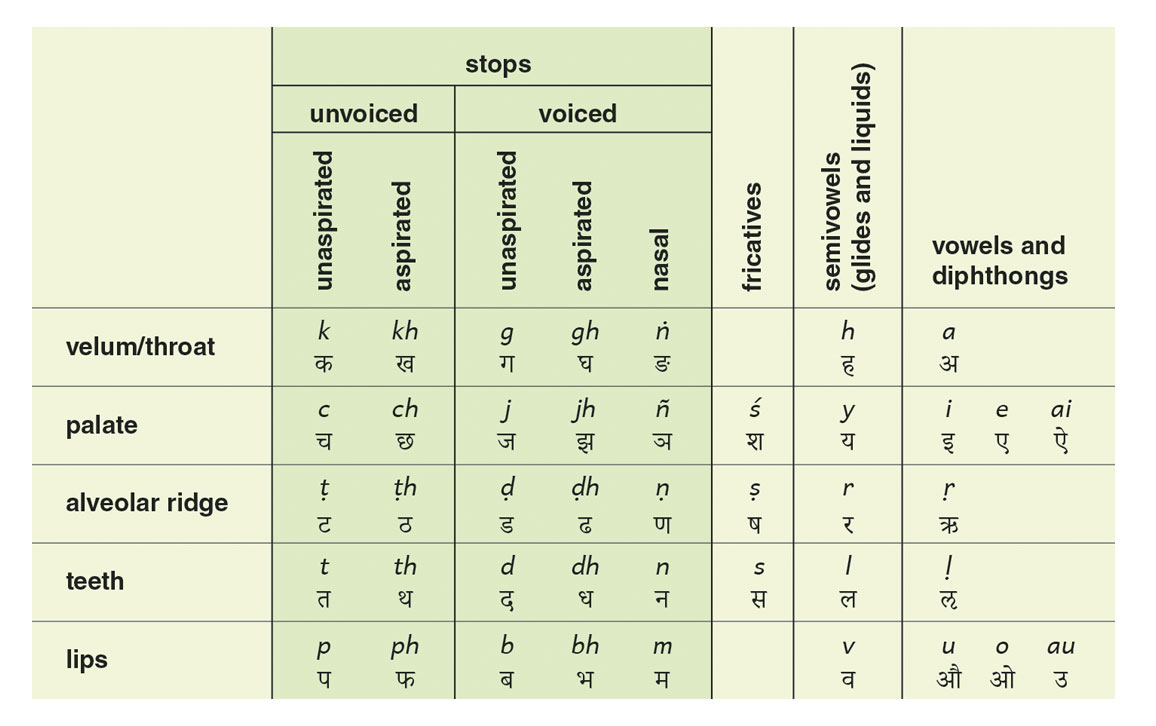The Grammar of the Elements
By Abhik Ghosh, Paul Kiparsky
Did the Sanskrit alphabet influence Mendeleev’s periodic table?
Did the Sanskrit alphabet influence Mendeleev’s periodic table?

Dmitri Ivanovich Mendeleev was not the first to recognize the periodicity of the chemical elements or even to construct a primitive periodic table. He did go much further than his peers, however, in conceptualizing periodicity as a fundamental law governing the nature of the elements. Based on that insight, whenever the properties of a given element didn’t fit the overall pattern, he famously left an empty spot in his table for an as yet undiscovered element. He used the prefixes eka, dvi, and tri, Sanskrit for the numbers one, two, and three, to name these hypothetical elements, referring to the number of places they were from a known, lighter element in the same group.
Let that sink in. Not Greek. Not Latin. Not even German, the lingua franca of science in continental Europe at the time. But Sanskrit, an ancient Indian language that few Europeans outside certain rarefied circles had even heard about. This unique decision led us, a chemist and a linguist, to explore what might have led Mendeleev to reference Sanskrit in this way.

De Agostini Picture Library/Bridgeman Images; Science History Images/Alamy Stock Photo; Abhik Ghosh
In general terms, the origin of Mendeleev’s periodic table is fairly well-known. As a freshly tenured professor at Saint Petersburg University in Russia in 1867, Mendeleev found himself responsible for teaching inorganic chemistry with no suitable textbook at hand. Characteristically, he set about writing his own—Osnovy Khimii [Principles of Chemistry]—between 1868 and 1870. During this period, while searching for a sensible order for discussing the chemistry of the approximately 65 elements known at the time, he hit upon the idea of the “periodic table.” His insight transformed chemistry from a trackless wilderness of disparate facts to something approaching a well laid-out garden.
Less is known about Mendeleev’s exact eureka moment, which came shortly before March 1, 1869. In one popular account, the idea of the periodic table occurred to Mendeleev while playing solitaire using a set of cards printed with the symbols and atomic weights of the elements. In another story, most likely apocryphal, the idea of the periodic table came to him in a dream, much as the correct structure of benzene supposedly came to August Kekulé in a dream (see “The Many Guises of Aromaticity” in the January–February 2015 issue).
To us, a third source of inspiration seems plausible, one that would also explain Mendeleev’s enigmatic use of the Sanskrit prefixes. Saint Petersburg at the time was a preeminent center of research on classical Oriental languages such as Sanskrit, and there is strong evidence that Mendeleev cultivated friends in that milieu. Further, the Sanskrit alphabet is a two-dimensional periodic array and, assuming Mendeleev saw it (an eventuality that we consider probable, as explained below), it would have been an obvious source of inspiration for the construction of other periodic systems.
Taking a longer view of things, it’s fair to say that Mendeleev’s periodic system grew out of a larger project on possible chemical compounds, which he had articulated in his 1861 “Essai d’une théorie sur les limites des combinaisons organiques [Essay of a theory on the limits of organic combinations].” He called the project chemical mechanics in his 1861 book Organic Chemistry, in which he credited the chemist Antoine-Laurent de Lavoisier with initiating the line of thinking. Lavoisier’s work also had a linguistic vein, as though by constructing a nomenclature that systematically reflected the chemical composition of a substance (for example, sulfuric/sulfurous, sulfate/sulfite, and so on), the theory of chemical compounds could be reduced to a kind of grammar. Mendeleev took this approach to a new level by formulating generalizations about chemical formulas.
Mendeleev’s search for a unifying language of chemistry may have led him to linguistics, and ultimately he may have been inspired by Sanskrit. Because of our familiarity with this ancient Indian language, we can see parallels that may have been overlooked in the past—parallels that may indicate why Mendeleev paid homage to it in his life’s greatest work.
To understand why Mendeleev used Sanskrit words in his periodic table, we first need to consider how he may have learned about a language that few Europeans knew about at that time. It turns out that in the middle of the 19th century Saint Petersburg University consisted of only four faculties (branches of learning), one of which was dedicated entirely to Oriental languages. Perhaps of greater significance was Mendeleev’s friendship with the eminent Indologist and philologist Otto von Böhtlingk, who worked at the Saint Petersburg Academy of Sciences during the first decade of Mendeleev’s career.

Wikimedia Commons
Böhtlingk is best known for his magnum opus, a seven-volume Sanskrit-German dictionary that he compiled over the course of 23 years (1853–1875), but he also translated and edited a whole raft of other major Sanskrit works. To what extent Mendeleev and Böhtlingk interacted on a daily basis is unknown. But we do know that the two men shared an interest in Siberia (Mendeleev’s birthplace) and promoted research on the Arctic. Indeed Böhtlingk composed a remarkable grammar of the Siberian language Yakut (also known as Sakha), in which he applied the principles of Sanskrit grammar to extraordinary effect. Böhtlingk also supported Mendeleev’s nomination for the Academy’s prestigious Demidov Prize, which the chemist won for his first textbook, Organic Chemistry.
The importance of Sanskrit to the study of linguistics and European languages was already well-known to European philologists and linguists at that time. They knew that Sanskrit is linguistically related to the great majority of modern European languages (with the exception of Finnish, Basque, and a handful of others) as well as Farsi (but not Turkish and Arabic). Indeed, the recognition of this linguistic kinship—as famously expressed by English philologist and judge Sir William Jones in a lecture to the Asiatic Society in Calcutta in colonial India on February 2, 1786—is often thought to mark the beginning of comparative linguistics and Indo-European studies:
The Sanscrit language, whatever be its antiquity, is of a wonderful structure; more perfect than the Greek, more copious than the Latin, and more exquisitely refined than either, yet bearing to both of them a stronger affinity, both in the roots of verbs and the forms of grammar, than could possibly have been produced by accident; so strong indeed, that no philologer could examine them all three, without believing them to have sprung from some common source, which, perhaps, no longer exists.
The “common source” to which Jones referred is now called proto-Indo-European. The seminomadic, horse- or chariot-riding Indo-European tribes who called themselves ārya (today known as Aryans) settled northern India around 1500 BCE and spoke an early form of Sanskrit, so-called Vedic Sanskrit, which is preserved in their religious text, the Rigveda (veda means knowledge, and is derived from the verb vid, to know, a cognate of Scandinavian vide/vite/veta, German wissen, and English wisdom).
A thousand or so years later (approximately 350–500 BCE), a Sanskrit scholar named Pāṇini—who lived in Gāndhāra, one of the great intellectual and artistic hotbeds of ancient India, which now straddles the Pakistan–Afghanistan border—formalized the grammar of the entire language in the Aṣṭādhyāyī. This seminal treatise consists of 3,959 rules organized into eight chapters. As it happens, Böhtlingk’s first major publication in 1839 was a German edition of the Aṣṭādhyāyī, which he titled Acht Bücher grammatischer Regeln [Eight Books of Grammatical Rules]. And foundational to the Aṣṭādhyāyī was a two-dimensional, periodic alphabet, which may have intrigued Mendeleev as he struggled to create his own periodic array.
The parallels between Pāṇini’s and Mendeleev’s work are striking enough to make us wonder whether the former inspired the latter. Pāṇini’s Aṣṭādhyāyī—literally the “eight-chaptered thing”—is an astonishing achievement. It provided the most concise, precise, and complete analysis of Sanskrit by rigorously adhering to what is now called the minimum description length principle: the idea that the best model is one that best compresses a set of information. Maximum compression of the grammatical rules was achieved by a rich array of symbols and abbreviations designed to express the most powerful rules in the briefest possible manner.
The insights emerging from his analysis first inspired linguists 200 years ago and continue to serve as an important source of ideas in the field today. For example, according to legendary Massachusetts Institute of Technology linguist Noam Chomsky, the Aṣṭādhyāyī provided the first “generative grammar” in the modern sense of the word, meaning a complete set of rules for combining morphemes (the smallest meaningful units of language, such as word roots and stems, prefixes and suffixes) into grammatical sentences. The work also provided comprehensive rules governing other aspects of the Sanskrit language, such as the phonological patterning of Sanskrit sounds (for example, how sounds change systematically as you slur them in speech), the formation of compound words (such as airplane, headache, or Schadenfreude), and interconversions among different parts of speech (for example, kind, kindly, and kindliness). One could use these rules to generate new words as well as novel expressions and sentences. In our view, what Pāṇini did for Sanskrit, Mendeleev tried to do for chemistry.

Wellcome Collection/CC BY 4.0
Pāṇini, like Mendeleev, did not operate in a vacuum, although his is the earliest work on Sanskrit grammar that has come down to us in full, unmutilated form. Vedic scholars who preceded him had already worked out a sophisticated theory of phonetics to help fix the pronunciation of sacred texts such as the Rigveda.
They classified speech sounds by their place of articulation and degree of aperture of the mouth and larynx, as shown in the diagram on below. Note that from top to bottom in the “two-dimensional alphabet,” the point of articulation moves outward in the oral cavity. For example, the first row of stops originates from the throat (the velars or gutturals), the second row from the soft palate (the palatals), and so on until the fifth row, which originates from the lips (the labials). Remarkably, the vowels can also be classified by the same system. Along the horizontal axis, the stops are organized according to increasing aperture, which correlates with increasing sonority or amplitude. These progressions may be likened to the increase in atomic weight along both axes of the periodic table.
The vertical columns also reflect phonetic features implemented by constricting the larynx and oral cavity to manipulate the airflow, such as voicing (meaning vibration of the vocal cords) and aspiration, which may be likened to valence and other chemical commonalities. The distinction between aspirated (breathy) and unaspirated (unbreathy) consonant pairs may be quite tricky for native English speakers. Such pairs are actually ubiquitous in English. Thus, the k in skill is unaspirated, but the k in kill is aspirated. Likewise for the t in stop (unaspirated) and top (aspirated). And the same for the j sound in hedge (unaspirated) and hedgehog (aspirated). For readers with some familiarity with Indian alphabets, we may add that the vowels a, i, and u also have longer variants, denoted in English as ā, ī, and ū. The vowels e and o and the diphthongs ai and ou, on the other hand, are always long.
What Pāṇini did for Sanskrit, Mendeleev tried to do for chemistry.
Despite being separated by two and a half millennia, Pāṇini and Mendeleev were uncannily similar in terms of both their goals and methods. First of all, both required a systematization of the basic building blocks of their subject, which in both cases turned out to be a periodic system. Pāṇini’s ordering of the sounds by place of articulation and aperture parallels Mendeleev’s ordering of the elements by their increasing atomic weight. On a more detailed note, just as Pāṇini treated the simple stops k, t, p, and so forth as basic, Mendeleev considered the seven light elements lithium through fluorine as typical (or representative) elements. (Note that inorganic chemists today do not view the first-row elements as the most representative of their groups; we would pick chlorine or bromine rather than fluorine as best representing the average properties of the halogens).
Second, as with the periodic table, Pāṇini’s framework for Sanskrit sounds wasn’t just organization for organization’s sake. His system allowed the formulation of a variety of generalizations about the existing phonological patterning of Sanskrit sounds. Phonology refers to the patterns of sounds in a language (for example, the fact that the sequence /pf/ is perfectly alright in German, as in Pfennig, but not in English), as opposed to the sounds themselves, their articulation and perception, and their acoustic properties, which are covered under phonetics. The Pāṇinian alphabet allowed the formulation of extensive rules for how Sanskrit sounds change when they follow one another, both in individual words and in sentences and fast speech. Going much further, Pāṇini sought and successfully formulated the shortest system of rules that generates all expressions in Sanskrit without generating any expressions that are not well formed. In an analogous approach, Mendeleev sought a “chemical grammar” that generates all chemical compounds, such as NaCl and CaCl2, without generating any impossible compounds, such as NaCl2 and CaCl, guided by what he called the principle of isomorphism (from ancient Greek: isos, “equal” and morphe, “form” or “shape,” in effect, similar molecular formulas).
Third, both men encountered occasional problems in reconciling the physical properties of their building blocks with their combinatoric properties. For example, the semimetallic element tellurium has a higher atomic weight than iodine, but their chemical properties suggest that tellurium should precede iodine in the periodic table. Mendeleev’s genius was indeed to place tellurium before iodine, in the hope that a more accurate determination of their atomic weights would rectify the discrepancy. In a series of 14 verses called the Śivasūtras, allegedly a revelation from the Hindu god Śiva, Pāṇini also rearranged the alphabet—occasionally in less than intuitive ways—so that classes of sounds that combine in the same way with each other are adjacent.

Barbara Aulicino
In our view, the above parallels are too extensive to result solely from coincidence. Although Mendeleev probably did not know Sanskrit to any appreciable degree, he almost certainly heard about Pāṇini and his periodic system of Sanskrit sounds from Böhtlingk. The latter perhaps also told him how he constructed a periodic system of Yakut speech sounds based on Pāṇinian principles, but with the palatal and dental consonants reversed because of the way they pattern in Yakut.
Mendeleev sought a “chemical grammar” that generates all—and only the possible—chemical compounds.
To us, it seems likely that Böhtlingk was the first to recognize the connection between Pāṇini’s and Mendeleev’s work and advised Mendeleev accordingly. On the other hand, we cannot exclude the possibility that Mendeleev knew enough to notice the connection himself, or that he had learned about Pāṇini’s system from Böhtlingk early enough to be inspired by it as he was developing his system. Either way, the interactions between the two men, which lasted for the better part of a decade, most likely came to an end when Böhtlingk moved to Germany in May of 1868, the year that Mendeleev started writing his Principles of Chemistry, and nine months before he sent his first write-up of the periodic system to the printer.
As for the tellurium-iodine conundrum, vindication did come for Mendeleev, but not in his lifetime and not as he had expected. The atomic weights were indeed more or less correct, but it turned out to be the atomic number (the number of protons in an atom’s nucleus), which usually but not always correlates with atomic weight, that fixes an element’s place in the periodic table.
As for Pāṇini, he became the model for scholarship in classical India. His role in the culture had been likened to that of Euclid in the West by the late Indologist Johan Frederik (Frits) Staal. In another sense, however, Pāṇini’s ultimate recognition came 2,500 years later: when his analytical techniques became a cornerstone of modern linguistics, minimum description length became recognized as a scientific principle, and it was discovered that linguistic rules can live on in daughter languages even after historical changes have disrupted their phonetic basis.
To us, Mendeleev’s remarkable use of the Sanskrit numerals eka-, dvi-, and tri- in naming as yet undiscovered elements makes the most sense as an homage to Pāṇini, not only to his periodic alphabet, but also more generally to his generative, combinatoric approach to language. Mendeleev presumably saw this approach as analogous to his own quest for a grammar of nature. One of the most iconic symbols of modern science, as it arose in the latter part of the 19th century in Europe, may thus owe a significant debt to an ancient Eastern language and culture.
Click "American Scientist" to access home page
American Scientist Comments and Discussion
To discuss our articles or comment on them, please share them and tag American Scientist on social media platforms. Here are links to our profiles on Twitter, Facebook, and LinkedIn.
If we re-share your post, we will moderate comments/discussion following our comments policy.